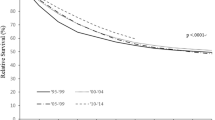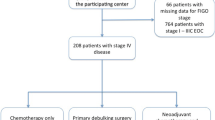Abstract
Purpose
To explore the risk factors in ovarian cancer with respects of time-varying effects on recurrence and survival.
Methods
Two hundred and ninety-eight patients with epithelial ovarian cancer in the Kaohsiung Veterans’ General Hospital from January 1995 to the end of 2011 were included in the study. The assumption of the Cox proportional hazard model, i.e., the hazard ratio is a constant with time, was tested for available prognostic factors. An extended Cox model was then applied, and a statistical package was constructed to perform multivariate analysis in presence of both time-varying and time-independent factors.
Results
Most prognostic factors met the assumption of the Cox proportional hazard model (p > 0.05) except for cancer-associated antigen (CA) 125 nadir concentration during first-line chemotherapy (p = 0.02). Multivariate analysis, where CA125 nadir was allowed to change with time while other factors remained constant, showed that International Federation of Gynecology and Obstetrics (FIGO) stage, residual tumor, CA125 nadir, and age were independent risk factors for recurrence and death.
Conclusions
The effect of CA125 nadir on recurrence and overall survival is not constant over time. It loses predictivity on recurrence and survival after 4.5 years. Awareness of the time-varying effects of the prognostic factors is beneficial to gynecologists in patient consultation and case evaluation.


Similar content being viewed by others
References
Gadducci A, Cosio S, Zola P, Landoni F, Maggino T, Sartori E. Surveillance procedures for patients treated for epithelial ovarian cancer: a review of the literature. Int Gynecol Cancer. 2007;17:21–31.
Su Z, Graybill WS, Zhu Y. Detection and monitoring of ovarian cancer. Clin Chim Acta. 2013;415:341–5.
Gupta D, Lis CG. Role of CA125 in predicting ovarian cancer survival—a review of the epidemiological literature. J Ovarian Res. 2009;2:13.
Makar AP, Baekelandt M, Trope CG, Kristensen GB. The prognostic significance of residual disease, FIGO substage, tumor histology, and grade in patients with FIGO stage III ovarian cancer. Gynecol Oncol. 1995;56:175–80.
Holschneider CH, Berek JS. Ovarian cancer: epidemiology, biology, and prognostic factors. Semin Surg Oncol. 2000;19:3–10.
Cox DR. Regression models and life-tables. J R Stat Soc B. 1972;34:187–220.
Martinussen T, Scheike TH. Dynamic regression models for survival data. New York: Springer; 2006.
R Development Core Team. R: A language and environment of statistical computing. Vienna, Austria: R Foundation for Statistical Computing; 2010.
Perperoglou A, le Cessie S, van Houwelingen HC. A fast routine for fitting Cox models with time varying effects of the covariates. Comput Methods Programs Biomed. 2006;81:154–61.
Peters-Engl C, Obermair A, Heinzl H, Buxbaum P, Sevelda P, Medl M. CA 125 regression after two completed cycles of chemotherapy: lack of prediction for long-term survival in patients with advanced ovarian cancer. Br J Cancer. 1999;81:662–6.
Giolo SR, Krieger JE, Mansur AJ, Pereira AC. Survival analysis of patients with heart failure: implications of time-varying regression effects in modeling mortality. PLoS One. 2012;7:e37392.
Tian L, Zucker D, Wei LJ. On the Cox model with time-varying regression coefficients. J Am Stat Assoc. 2005;100:172–83.
Liu ML, Lu WB, Shore RE, Zeleniuch-Jacquotte A. Cox regression model with time-varying coefficients in nested case-control studies. Biostatistics. 2010;11:693–706.
van Altena AM, Kolwijck E, Spanjer MJ, Hendriks JC, Massuger LF, de Hullu JA. CA125 nadir concentration is an independent predictor of tumor recurrence in patients with ovarian cancer: a population-based study. Gynecol Oncol. 2010;119:265–9.
Markman M, Liu PY, Rothenberg ML, Monk BJ, Brady M, Alberts DS. Pretreatment CA-125 and risk of relapse in advanced ovarian cancer. J Clin Oncol. 2006;24:1454–8.
Juretzka MM, Barakat RR, Chi DS, Iasonos A, Dupont J, Abu-Rustum NR, et al. CA125 level as a predictor of progression-free survival and overall survival in ovarian cancer patients with surgically defined disease status prior to the initiation of intraperitoneal consolidation therapy. Gynecol Oncol. 2007;104:176–80.
Prat A, Parera M, Peralta S, Perez-Benavente MA, Garcia A, Gil-Moreno A, et al. Nadir CA-125 concentration in the normal range as an independent prognostic factor for optimally treated advanced epithelial ovarian cancer. Ann Oncol. 2008;19:327–31.
Kang S, Seo SS, Park SY. Nadir CA-125 level is an independent prognostic factor in advanced epithelial ovarian cancer. J Surg Oncol. 2009;100:244–7.
Riedinger JM, Wafflart J, Ricolleau G, Eche N, Larbre H, Basuyau JP, et al. CA 125 half-life and CA 125 nadir during induction chemotherapy are independent predictors of epithelial ovarian cancer outcome: results of a French multicentric study. Ann Oncol. 2006;17:1234–8.
Aalen OO. Further results on the non-parametric linear regression model in survival analysis. Stat Med. 1993;12:1569–88.
Mckeague IW, Sasieni PD. A partly parametric additive risk model. Biometrika. 1994;81:501–14.
Chiang AJ, Chen J, Chung YC, Huang HJ, Liou WS, Chang C. A longitudinal analysis with CA-125 to predict overall survival in patients with ovarian cancer. J Gynecol Oncol. 2014;25:51–7.
Govindarajulu US, Spiegelman D, Thurston SW, Ganguli B, Eisen EA. Comparing smoothing techniques in Cox models for exposure-response relationships. Stat Med. 2007;26:3735–52.
Acknowledgment
The study was supported in part by a Grant from the National Science Council of Taiwan (NSC 102-2118-M-110-003) and two Grants from KSVGH (VGHKS103-086 and VGHNSU103-006).
Disclosure
The authors declare no conflict of interest.
Author information
Authors and Affiliations
Corresponding author
Rights and permissions
About this article
Cite this article
Chang, C., Chiang, A.J., Wang, HC. et al. Evaluation of the Time-Varying Effect of Prognostic Factors on Survival in Ovarian Cancer. Ann Surg Oncol 22, 3976–3980 (2015). https://doi.org/10.1245/s10434-015-4493-4
Received:
Published:
Issue Date:
DOI: https://doi.org/10.1245/s10434-015-4493-4




